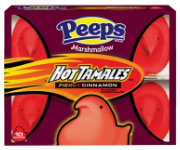 This post first appeared last year. It is being reused due in part to 2020’s reduced mobility and (apparently) creativity. Articles in USA Today and elsewhere, include Root Beer Float in a list of five new Peeps flavors but, as can be seen below and in the original post, the flavor was already around in 2019. Hot Tamales Fierce Cinnamon, on the other hand, really does appear to be making its debut this year.
This post first appeared last year. It is being reused due in part to 2020’s reduced mobility and (apparently) creativity. Articles in USA Today and elsewhere, include Root Beer Float in a list of five new Peeps flavors but, as can be seen below and in the original post, the flavor was already around in 2019. Hot Tamales Fierce Cinnamon, on the other hand, really does appear to be making its debut this year.

Today is Easter. I know that because I looked it up on the internet. It was easy. It was easy in the early days, too. Easter was originally simply the Sunday of Passover week. Since most early Christians had once been Jews, they just naturally knew when Passover was. Even those that had converted to Christianity directly from Druidism probably had some Jewish friends they could ask. Easy, peasy. Too easy, it seems, for some.
Things changed in 325 at the First Council of Nicaea. Maybe the priests felt threatened by pretty much everybody knowing when Easter was without asking. Or maybe the astronomers, who might have been the same guys, were feeling left out. Or maybe the priests just weren’t all that happy having a Christian holiday tied so tightly to a Jewish one. So, they tied it, instead, to the moon and the sun.
Their starting point was the vernal equinox when the sun is directly above Earth’s equator and day and night are of equal length. Next was a full moon which occurs when the surface visible to Earth is completely illuminated by the sun. These two events are not synchronized. A vernal equinox happens every 365.24 days; A full moon every 29.53 days. But even the most radical of the Nicaea councilors dared not mess with the idea that Easter was a Sunday thing. That meant that a mostly arbitrary period of seven days and the completely arbitrary selection of one of the seven were overlaid on the two asynchronous sun and moon events. Henceforth, Easter would be celebrated on the first Sunday after the first full moon after the vernal equinox.
That probably sounds a bit involved and confusing to many people today let alone 4th-century peasants. Come spring of 326, priests were no doubt busy letting the laity know when they should hide their eggs and have relatives over for baked ham.
In the centuries since, alternate sources of the information have proliferated. Asking a priest continues to be an option, but one that has been unnecessary since sometime in the 20th century when the majority of refrigerators became covered by calendars — with Easter marked in red — from every merchant and insurance agent in the area. The time saved has been put to good use finding ways to enhance the Easter experience. A Lego bunny and never before seen colored and flavored Peeps are available for 2019. And scheduling egg hunts has become even easier. “Hey Google. When’s Easter?”
